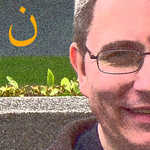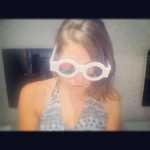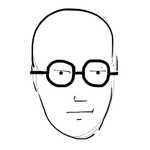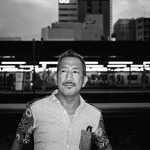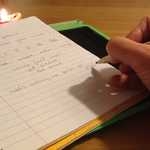

Yalmay Yunupingu tells the story of the sacred walking stick of the Djankawu
October 18th, 2013, 9am
This painting by Yalmay Yunupiŋu is the only work of great significance in my very modest collection of indigenous art from around the world. Painted in 1989 (ochre on bark), it has for many years occupied a place of honor in my house in Victoria, far from the dreamtime events it depicts. These events occurred at Yalangbara in the far north. I can think of a dozen stories I could tell you relating to this wonderful image: the significance of the ancient Djankawu story cycle itself; the wonderful Marika family of artists who are the custodians of this creation story; the details of the amazing Wagilag sisters who gave birth to the world; the meaning of the digging (or walking) stick they used to create freshwater wells, landforms, while singing and naming the plants and animals which they encountered as they traveled from the sunrise to the sunset; the highly significant legal role played by the ceremonial digging stick (now on exhibit in Parliament House in Canberra) in the Aboriginal land rights cases; the many educational, cultural and activist achievements of the artist Yalmay (Marika) Yunupingu; the achievements of Yalmay’s husband, Dr. Yunupingu, lead singer of the band Yothu Yindi
Well, I better not try to tell all that today, so just a couple more things. Yalmay’s bark tells just one component of the complex account of the Wagilag creation sisters. Their story is told in many forms in Arnhem Land, in the Northern Territory of Australia. No-one is allowed to go to the sacred site where these events occurred – not men, women or children, Indigenous or non-Indigenous. But you can learn the gist of this dark and moving creation story by watching a short animation sequence: http://www.abc.net.au/dustechoes/dustEchoesFlash.htm [you will need to explore this mysterious animated landscape looking for the Wagalak sisters story circle.
Yalmay’s close relation Wandjuk Marika puts into words the part of the story depicted in Yalmay’s bark that hangs in my house. “This is the special ground, Bilapinya. You can see two birds, bustards, and one walking stick, which is there. The Djan’kawu put it there and you can see all the trees, . . . , but where the two bustards are standing looking at the ground, Bilapinya, you can see the sign there that’s the grass and a little berry, food. On this painting you can see the walking stick, the special Mawalan Stick. On the bottom you can see the flat part for paddling on the sea in the canoe. They used this special Malawan as a paddle for paddling through the ocean to Yalangbara. This is the sacred walking stick I took to the land rights case to explain what the land is. The land is not empty.”

Mawalan (2) Marika and Yalmay Yunupingu holding the sacred digging stick, now hanging in Parliament House. To learn more about the digging stick, go to http://www.nma.gov.au/exhibitions/yalangbara/material_objects_and_meaning This link takes you to a large website that gives a clear and informative account of the Art of the Djankawu and the Marika family.
 To learn more about Yalmay’s recent activism, visit http://www.ntnews.com.au/article/2013/10/17/326252_ntnews.html
To learn more about Yalmay’s recent activism, visit http://www.ntnews.com.au/article/2013/10/17/326252_ntnews.html
Both Yalmay and her husband (whose first name is omitted here out of respect for Yolgnu cultural protocols in relation to the recently deceased) have made highly significant contributions to the coming together of Australia’s two cultures. Formed in 1986, Yothu Yindi consists of both Yolngu (Aboriginal)and Balanda (non-Aboriginal) musicians and embodies a sharing of cultures. The band promotes the strength of Yolngu culture, presenting non-Aboriginal people throughout the world with an opportunity to appreciate and enjoy aspects of that ancient culture. If you don’t know the song Treaty (Yothu Yindi, Paul Kelly and Midnight Oil), then you should drop what you’re doing and go listen to it at http://www.youtube.com/watch?v=tmribehZGM8
Lyrics of the Yothu Yindi song “Treaty”
Well I heard it on the radio And I saw it on the television But promises can be broken Just like writing in the sand Treaty yeah treaty now treaty yeah treaty now
Nhema gayakaya nhe gayanhe Nhe gayanhe matjini walangwalang nheya Nhimadjatpanhe walang Gumurrtjararrk yawirriny Nhe gaya nhe matjini Gaya gaya nhe gaya nhe Matjini walangwalang Nhema djat’pa nhe walang Nhe gumurrtjarrk nhe ya
This land was never given up This land was never bought and sold The planting of the union jack Never changed our law at all Now two rivers run their course Separated for so long I’m dreaming of a brighter day When the waters will be one
Treaty yeah treaty now treaty yeah treaty now Treaty yeah treaty now treaty yeah treaty now Treaty yeah treaty ma treaty yeah treaty ma Treaty yeah treaty ma treaty yeah treaty ma
Finally, if you would like to consult a much fuller account of the Yolngu with over 100 full colour illustrations, see Singing the land, signing the land, a book by Helen Watson, The Yolngu community at Yirrkala, and David Wade Chambers.
Though now long out of print the book can be found online: http://singing.indigenousknowledge.org/
Filed Under
Other moments in Aireys Inlet
-
Burning, poem, Books
Burning the Books
in Aireys Inlet, Australia -
Today's Sunrise, poem
Beginning or End?
in Aireys Inlet, Australia -
Verses for Emlyn, Grandfathers, family fun
Grandad Wade
in Aireys Inlet, Australia -
Verses for Emlyn, Roses, flowers
Beauty
in Aireys Inlet, Australia -
The Small Things, Depression
Small blessings #4: Just a touch of rose.
in Aireys Inlet, Australia -
Verses for Emlyn, birds, bird bath
Seven
in Aireys Inlet, Australia -
Atheism, Today's Sunrise
Glory
in Aireys Inlet, Australia -
Today's Sunrise, Today's Coffee, health
Morning Cuppa
in Aireys Inlet, Australia -
Verses for Emlyn, kangaroo, wildlife
Alert
in Aireys Inlet, Australia
